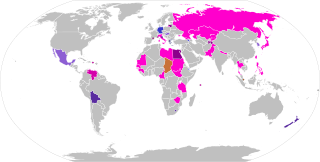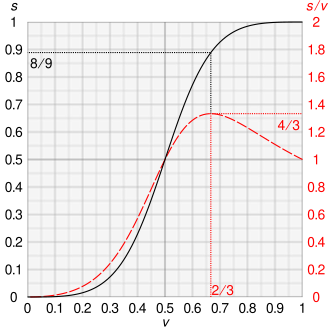
Proportional representation (PR) refers to any type of electoral system under which subgroups of an electorate are reflected proportionately in the elected body. The concept applies mainly to political divisions among voters. The essence of such systems is that all votes cast – or almost all votes cast – contribute to the result and are effectively used to help elect someone. Under other election systems, a bare plurality or a scant majority are all that are used to elect candidates. PR systems provide balanced representation to different factions, reflecting how votes are cast.
The electoral threshold, or election threshold, is the minimum share of votes that a candidate or political party requires before they become entitled to representation or additional seats in a legislature.
In political science, Duverger's law holds that in political systems with single-member districts and the plurality voting system,, two main parties tend to emerge. In this case, votes for minor parties can potentially be regarded splitting votes away from the most similar major party. In contrast, systems with proportional representation usually have more representation of minor parties in government.

Mixed-member proportional representation is a type of representation provided by some mixed electoral systems which combine local winner-take-all elections with a compensatory tier with party lists, in a way that produces proportional representation overall. Like proportional representation, MMP is not a single system, but a principle and goal of several similar systems. Some systems designed to achieve proportionality are still called mixed-member proportional, even if they generally fall short of full proportionality. In this case, they provide semi-proportional representation.

The D'Hondt method, also called the Jefferson method or the greatest divisors method, is an apportionment method for allocating seats in parliaments among federal states, or in proportional representation among political parties. It belongs to the class of highest-averages methods. Compared to ideal proportional representation, the D'Hondt method reduces somewhat the political fragmentation for smaller electoral district sizes, where it favors larger political parties over small parties.

The Webster method, also called the Sainte-Laguë method, is a highest averages apportionment method for allocating seats in a parliament among federal states, or among parties in a party-list proportional representation system. The Sainte-Laguë method shows a more equal seats-to-votes ratio for different sized parties among apportionment methods.

In political science, parallel voting or superposition refers to the use of two or more electoral systems to elect different members of a legislature. More precisely, an electoral system is a superposition if it is a mixture of at least two tiers, which do not interact with each other in any way; one part of a legislature is elected using one method, while another part is elected using a different method, with all voters participating in both. Thus, the final results can be found by calculating the results for each system separately based on the votes alone, then adding them together. A system is called fusion or majority bonus, another independent mixture of two system but without two tiers. Superposition is also not the same as "coexistence", which when different districts in the same election use different systems. Superposition, fusion and coexistence are distinct from dependent mixed electoral systems like compensatory (corrective) and conditional systems.

Rein Taagepera is an Estonian political scientist and former politician.

The Gallagher index measures an electoral system's relative disproportionality between votes received and seats in a legislature. As such, it measures the difference between the percentage of votes each party gets and the percentage of seats each party gets in the resulting legislature, and it also measures this disproportionality from all parties collectively in any one given election. That collective disproportionality from the election is given a precise score, which can then be used in comparing various levels of proportionality among various elections from various electoral systems. The Gallagher index is a statistical analysis methodology utilised within political science, notably the branch of psephology.
In electoral systems, a wasted vote is any vote cast that is not "used" to elect a winner, and so is not represented in the outcome. However, the term is vague and ill-defined, having been used to refer to a wide variety of unrelated concepts and metrics. The precise definition of a wasted vote can have a major impact on the conclusions of an analysis. For example, under the narrowest possible definition of a wasted vote, the single transferable vote (STV) can be considered to waste zero votes. However, if the wasted vote definition is expanded even slightly, it is possible for up to 100% of STV votes to be classified as wasted because STV fails the unanimity criterion; that is, it is possible to elect a legislature that every single voter agrees is worse than some alternative.

Apportionment is the process by which seats in a legislative body are distributed among administrative divisions, such as states or parties, entitled to representation. This page presents the general principles and issues related to apportionment. The page apportionment by country describes the specific practices used around the world. The page Mathematics of apportionment describes mathematical formulations and properties of apportionment rules.
Matthew Søberg Shugart is an American political scientist. He is a Distinguished Professor of political science at the University of California, Davis. He is also an Affiliated Professor at the University of Haifa. Shugart specializes in electoral systems, party systems, and the design of political institutions, primarily through empirical studies of political systems across large numbers of countries. Shugart is also an orchardist, and runs the Fruits and Votes blog on electoral systems and fruit growing.

In political science, the effective number of parties is a diversity index introduced by Laakso and Rein Taagepera (1979), which provides for an adjusted number of political parties in a country's party system, weighted by their relative size. The measure is especially useful when comparing party systems across countries.
Elections to the Supreme Soviet were held in the Estonian SSR on 18 March 1990. Altogether 392 candidates ran for the Soviet-style legislature's 105 seats, of which four were pre-allocated to the military districts of the Soviet Army. The pro-independence Popular Front won the plurality. The coalition of the reformed Estonian communists, who favored independence but close relations with the USSR and were supported by Indrek Toome who was running under the Free Estonia banner, won 27 seats. The anti-independence, pro-Moscow "Joint Soviet of Work Collectives", representing mostly the ethnic Russian immigrant minority in Estonia, won 25 seats. During its first session, the new legislature elected the former Communist Party member Arnold Rüütel as its chairman, allowing him to stay as the nominal leader of Estonia.
Electoral reform is a change in electoral systems which alters how public desires are expressed in election results.
In voting theory, the micromega rule holds that, when political parties choose electoral systems, "the large prefer the small and the small prefer the large". The term "micromega" references Micromégas, a tale by Voltaire in which dwarfs and giants dialogue.

An electoral or voting system is a set of rules used to determine the results of an election. Electoral systems are used in politics to elect governments, while non-political elections may take place in business, non-profit organisations and informal organisations. These rules govern all aspects of the voting process: when elections occur, who is allowed to vote, who can stand as a candidate, how ballots are marked and cast, how the ballots are counted, how votes translate into the election outcome, limits on campaign spending, and other factors that can affect the result. Political electoral systems are defined by constitutions and electoral laws, are typically conducted by election commissions, and can use multiple types of elections for different offices.

A mixed electoral system is one that uses different electoral systems to elect different seats in a legislature. Most often, this involves a winner-take-all component combined with a proportional component. The results of the combination may be mixed-member proportional (MMP), where the overall results of the elections are proportional, or mixed-member majoritarian, in which case the overall results are semi-proportional, retaining disproportionalities from the majoritarian component. Systems that use multiple types of combinations are sometimes called supermixed.

Mixed-member majoritarian representation (MMM) is type of a mixed electoral system combining winner-take-all and proportional methods, where the disproportional results of the winner-take-all part are dominant over the proportional component. Mixed member majoritarian systems are therefore categorized under semi-proportional representation, and are usually contrasted with mixed-member proportional representation (MMP) which aims to provide proportional representation compensation ("top-up") seats.

Political fragmentation is the division of the political landscape into so many different parties and groups that the governance might become inefficient. Political fragmentation can apply to political parties, political groups or other political organisations. It is most often operationalized using the effective number of parliamentary parties.







